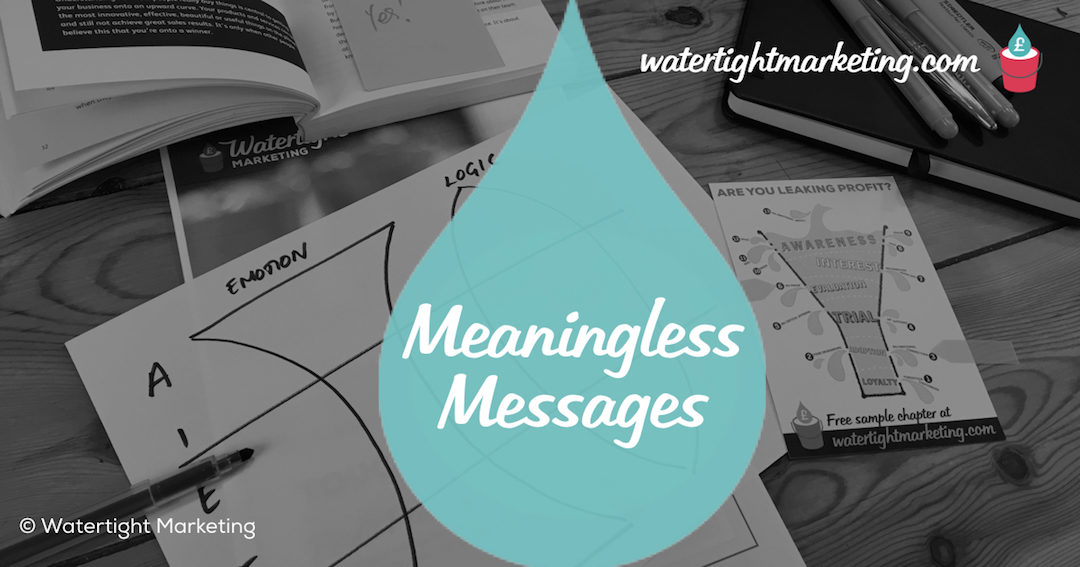We’re not going to be the first or last to say that you need to focus on emotional marketing messages to get a response. In using our Logic Sandwich™ messaging framework, we ask clients to focus on on ‘away-from’ emotional triggers to get a buying decision moving.
These are typically things that are frustrating people, for which your products or services are a potential answer. In doing this, you’ll usually reach a theme, or a range of themes fairly easily. You’ll need to go further to truly engage people emotionally.
Finding emotional marketing messages in common frustrations
You’ll have heard marketers guide you to more emotional marketing messages by asking you to think:
- What are the points of pain?
- What keeps your customers awake at night?
- What do your customers get annoyed about?
These are good places to start. They usually bring you to a few key themes. Let’s try ours on you to see if these start to ring a bell. We have three typical client profiles…
- Profile: A single-person business, e.g. a consultant, creative supplier or therapist. Themes: 1) I don’t have enough time for marketing because I’m working with clients. 2) I wish I could pick and choose who to work with. 3) I don’t feel confident about marketing to know I’m doing the right things.
- Profile: A step-up business with a small team and big potential. Themes: 1) The founder is the bottle-neck on decisions being made. 2) I think I want to recruit or outsource my marketing. 3) Need to systemise to scale the business.
- Profile: A SME with a pretty established team and product reaching a key milestone like gaining investment, selling the business, or taking on an MD to succeed the founder. Themes: 1) We’ve hit a plateau in sales and it’s proving hard to break through. 2) We need to document the way we do things so that someone external gets the value. 3) What got us here won’t get us there, we need to get more strategic.
This gets you a good way towards emotional marketing messages that might work. However, if you don’t drill down, these messages can still prove meaningless in practice. That’s because they are themes, rather than real life scenarios. Themes are vague and amorphous. Scenarios are specific and (if well constructed) totally compelling.
Go further, set a scene for your theme
Great novels, movies and dramas have themes going on. But, it’s the scenario that draws you in. Let’s take a look a few…
- Dirty Dancing: A film on a theme of coming of age and finding your own voice. The scenario is a rich girl at a Summer camp who falls in love with a rather sexy dancer that her Dad doesn’t approve of.
- Breaking Bad: A drama series with a theme of the depravity humans are capable of in given contexts. The scenario is a chemistry teacher with cancer who becomes a big time drug dealer and murderer.
Now, your marketing might not be aiming to become a cult classic on our screens. But, it does need to trigger an emotional response and draw people in. You do this by extending your theme into a real-life scenario into which your potential customer can project themselves. This means taking your emotional marketing messages further. Take the theme you’ve come up with, and then ask how this actually shows up in their lives. In what real, everyday, ways does this frustration manifest? Let’s run an example.
Theme: I don’t have enough time for marketing
Scenarios:
- Business owner sitting at a desk on sunny Sunday whilst their family has fun in the garden.
- An overflowing file and jotter of marketing ideas that never get actioned.
- A website with out-of-date information on it that means they’re embarrassed of it.
If you run this process for each of the client profiles, and for each of the themes, you can see how we’d quickly build up a compelling set of scenarios on which to centre content that would be much more likely to get some attention.
You can’t connect with a marketing message without a scenario
Where you’re aiming to catch someone’s attention, making an emotional connection is critical. The human brain can quickly filter and ignore a theme. It might be vaguely interesting, but it doesn’t require their immediate attention. In Leak 13: No Emotional Connection, (See Watertight Marketing, Chapter 8), we guide clients to find something that is harder to ignore. This means going beyond the standard ‘point of pain’ to a real-life scenario.
So, if you’ve found that your messages still aren’t getting a response, even though you’re talking about a point of pain that should be familiar to your audience, you may need to drill that bit deeper to bring them to life. If you can draw people into that world you’ll connect them with the discomfort that they want to address. When you can get to scenarios you can start to build imagery, analogies, headlines and questions that mean that people picture themselves in the scene you’re setting.
This gets you to your ‘away-from’ emotional trigger and closer to a sale.
© Bryony Thomas

Bryony Thomas
Author & Founder, Watertight Marketing
Bryony Thomas is the multi-award winning creator of the Watertight Marketing methodology, captured in the best-selling book of the same name. Bryony is a popular professional speaker for entrepreneurial audiences. Bryony's impressive career includes heading up the Microsoft account in the UK aged 26, and securing the role of divisional director of marketing for FTSE 100, Experian, aged 28.


